Disclosure: We may earn commissions if you purchase products after clicking on a link from our site.
If you’re looking to bag a turkey this hunting season, you’ll need to learn how to scout turkeys. In this guide, we’ll teach you everything you need to know about how to scout turkeys and take them down. From identifying the signs of a turkey’s presence to using calls and decoys to lure them in.
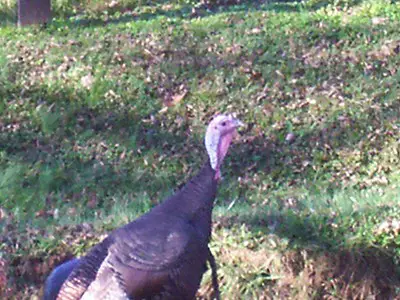
Table of Contents
How To Scout Turkeys
1. Roosting Areas
When scouting for turkeys, one of the important things to do is find where they roost. Turkeys usually roost in tall trees with large branches. One of the ways to find roosting areas is to be up early in the morning and carefully listen for the gobbling of the turkeys. This will give you an idea of where they are roosting.
Roosting areas play a crucial role in scouting turkeys, particularly for hunters aiming to locate them before the hunting season begins. These areas are where turkeys spend their nights resting, typically high up in trees to avoid predators.
Identifying roosting sites requires careful observation of turkey behavior, such as tracking their movements during dusk as they fly up to roost. Turkeys often favor large, mature trees with sturdy branches that provide security and shelter.
Additionally, listening to turkey calls at dawn can help pinpoint their roosting locations. By scouting roosting areas, hunters can develop strategies for approaching turkeys during the hunting season, including setting up blinds or choosing optimal hunting positions near these key locations. Understanding and locating roosting areas is essential for successful turkey hunting, as it provides valuable insights into turkey behavior and patterns.
2. Diverse Habitat
When scouting for turkeys, look for areas with diverse habitats that can offer a lot for the turkeys. Turkeys need food, water, cover, mature trees to roost in, and nesting cover. Look for hills, creek bottoms, ridges, woods, forest land, wetlands, plots of land with crops like corn, etc.
When scouting turkeys, searching for areas with diverse habitats is a fundamental strategy for locating these elusive birds. Turkeys thrive in environments that offer a variety of food sources, cover, and roosting sites.
Diverse habitats can include woodlands, open fields, brushy areas, and edge habitats where different vegetation types meet. These areas provide turkeys with ample forage options, such as seeds, insects, fruits, and tender shoots.
Furthermore, diverse habitats offer turkeys suitable nesting sites and cover from predators. When scouting, hunters should explore transitions between different habitat types, as turkeys often frequent these ecotones for feeding and roosting. By targeting areas with diverse habitats, hunters increase their chances of encountering turkeys and gain valuable insights into their behavior and movement patterns, ultimately enhancing their hunting success.
3. Droppings
When you locate areas with diverse habitats, study them carefully for signs that turkeys are active in that area. Look out for droppings, feathers, and tracks before the season opens. Look along the roadways for fresh turkey tracks.
When learning how to scout turkeys, one effective strategy is to search for turkey droppings, also known as scat. Turkey droppings are a valuable sign indicating the presence of these birds in an area. Typically, turkey droppings are cylindrical, often resembling small piles or elongated pellets, and vary in color depending on the bird’s diet and hydration level.
Fresh droppings are moist and dark, while older ones may appear dried out and lighter in color. By identifying turkey droppings, hunters can determine the recent activity of turkeys in a particular area, helping them pinpoint potential roosting, feeding, and strutting locations.
Additionally, the size and quantity of droppings can provide clues about the number and size of the turkey flock. When scouting, hunters should carefully observe the ground for signs of turkey droppings along trails, in feeding areas, near roosting sites, and around water sources, as these indicators can guide their hunting strategies and increase their chances of encountering turkeys.
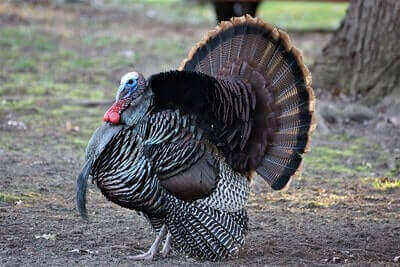
4. Trail Cameras
Use a trail camera in an area you think turkeys visit. From the trail camera, you will learn if turkeys are in that area and what is their behavior at different times during the day. Trail cameras are like an extra set of eyes for gathering information that works 24 hours a day. You can read about the best trail cameras available today from this review. Additionally, you can also learn the best trail camera tips to get the best use of trail cameras.
Trail cameras are invaluable tools for hunters learning how to scout turkeys. These cameras are strategically placed in target areas, such as known roosting spots, feeding areas, or travel corridors frequented by turkeys.
Equipped with motion sensors, trail cameras automatically capture images or videos of passing wildlife, including turkeys, providing hunters with valuable insights into turkey behavior, movement patterns, and population dynamics.
By reviewing the images captured by trail cameras, hunters can gather crucial information about the number, size, and gender composition of turkey flocks in the area, as well as their daily routines and preferred habitats. This data allows hunters to identify prime locations for setting up blinds or ambush points, plan hunting strategies based on turkey activity patterns, and increase their chances of a successful hunt.
Additionally, trail cameras provide hunters with the opportunity to monitor turkey behavior remotely without disturbing the birds, enabling them to make informed decisions and adjust their approach accordingly. Overall, incorporating trail cameras into turkey scouting efforts can significantly enhance the effectiveness and efficiency of the hunting experience.
5. Calls & Decoys
Once the turkey season begins, you can add calls and decoys to your arsenal for luring turkeys to you. Listen to the sounds they make and imitate them. You can attract their attention by making the sounds they make and lure them closer to you. Carefully study the different sounds turkeys make. They can give you an idea of what they are doing and where they are located.
When learning how to scout turkeys, utilizing calls and decoys can be instrumental in attracting and observing these elusive birds. Turkey calls, such as box calls, slate calls, or diaphragm calls, mimic the sounds made by turkeys to communicate with one another, including gobbling, yelping, purring, and clucking.
By mastering different turkey calls and using them effectively in the field, hunters can create realistic vocalizations that lure turkeys within range, allowing them to observe the birds’ responses and behaviors up close.
Additionally, deploying turkey decoys, which are lifelike replicas of turkeys, can further enhance the effectiveness of calls by providing visual stimuli that draw turkeys into the area. Decoys come in various designs, including hen decoys, Jake decoys, and tom decoys, each serving different purposes in attracting turkeys and eliciting specific reactions.
By strategically placing decoys in conjunction with natural cover and terrain features, hunters can create convincing turkey scenarios that entice real birds to approach, providing valuable opportunities for scouting and observation. Overall, incorporating calls and decoys into turkey scouting techniques allows hunters to interact with turkeys in their natural environment, learn their behaviors and habits, and ultimately increase their chances of a successful hunt.
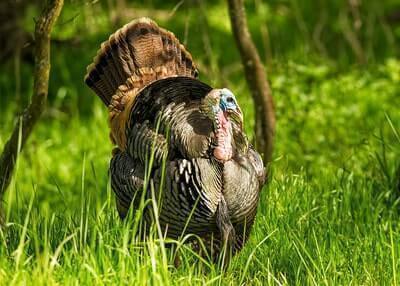
6. E-Scouting
Before the season starts, you can take advantage of technology to gather information on turkeys. There are apps that you can use like, HuntStand, onX, TrophyTracks, and BaseMap, to locate possible roost sites, food sources, and travel routes. With this information, you can get to those areas and do boots-on-the-ground scouting to verify the information obtained from the app.
E-scouting, or electronic scouting, has become an invaluable tool for hunters learning how to scout turkeys. This technique involves using various online resources and digital mapping platforms to study terrain features, habitat types, and potential turkey hotspots before heading into the field.
E-scouting allows hunters to access detailed topographic maps, satellite imagery, and aerial views of prospective hunting areas, enabling them to identify roosting sites, feeding areas, travel corridors, and other key turkey habitats from the comfort of their own homes.
By analyzing satellite imagery and terrain maps, hunters can pinpoint potential turkey roosts, strut zones, and nesting areas, as well as locate suitable ambush points and setup locations for hunting blinds or stands.
Additionally, e-scouting platforms often provide valuable information on public land boundaries, access points, and regulations, helping hunters plan their scouting and hunting strategies more effectively. By combining traditional scouting methods with e-scouting techniques, hunters can maximize their chances of success and make the most of their time in the field pursuing turkeys.
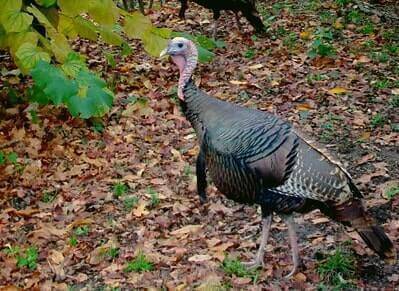
7. Scratching
Turkeys scratch in leaves looking for insects and acorns. Keep an eye out for heavy scratching on the ground. Observe if you can identify their claw marks. Turkeys scratch down to the soil leaving their claw marks in the soil. This could be the work of turkeys in search of food. They usually scratch near roost sites. If you find feathers and droppings near the scratching sites, then it’s almost certain that they are the work of turkeys.
When learning how to scout turkeys, looking for turkey scratches on the ground can be a valuable technique. Turkey scratches are areas where turkeys have been actively foraging for food, typically in search of insects, seeds, and other edible vegetation.
These scratches often appear as disturbed patches of soil or leaf litter, marked by shallow depressions or scrapes created by the turkeys’ feet as they scratch and rake the ground in search of food. By identifying these telltale signs of turkey activity, hunters can narrow down potential feeding areas and pinpoint locations where turkeys are actively frequenting.
Turkey scratches are especially prevalent in areas with soft, loose soil or leaf litter, such as forest edges, field margins, and open woodlands. By scouting for turkey scratches, hunters can gather valuable intelligence about turkey movements, feeding patterns, and habitat preferences, helping them plan their hunting strategies more effectively and increase their chances of encountering turkeys in the field.
8. Travel Routes
All living things have habits that are repeated regularly whether they realize it or not. Turkeys are no exception. They tend to travel the same routes every day. When scouting for turkeys before the season begins, try to find travel routes. You might find turkey droppings, feathers, and other signs. The turkey apps can also identify potential travel routes that you can visit to confirm.
If you locate roost sites and feeding areas, the travel routes can easily be located between these two areas. It is a great place to hunt in the mid-morning and late afternoon. Deer trails, old logging roads, ridgetops, oak flats, river bottoms, funnels, and pinch points between waterways are often used by turkeys as travel routes.
When learning how to scout turkeys, it’s essential to identify turkey travel routes as part of the scouting process. Turkey travel routes are the paths that turkeys take between their roosting areas, feeding sites, and other essential locations within their home range.
These routes often consist of well-worn trails or pathways through the habitat, characterized by flattened vegetation, scattered feathers, and other signs of frequent turkey activity. By locating and monitoring these travel routes, hunters can gain valuable insights into the daily movements and behavior patterns of turkeys, helping them predict where turkeys are likely to be at different times of the day.
Travel routes may include paths along field edges, forest openings, creek bottoms, and ridgelines, depending on the terrain and habitat features of the hunting area. By scouting for turkey travel routes, hunters can strategically position themselves along these pathways during hunting trips, increasing their chances of encountering turkeys as they move between roosting and feeding areas.
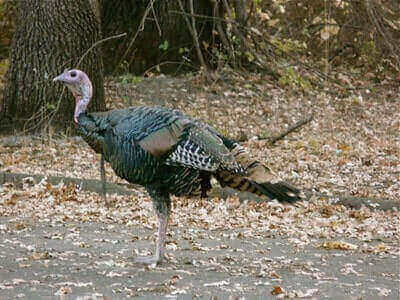
9. Glass For Turkeys
You can also scout for turkeys by using a binocular or a spotting scope to look for turkeys in the trees. We did a review of the best spotting scopes available today to help you find the best scope for your expeditions.
When learning how to scout turkeys, employing the technique of “glassing” can be highly effective. Glassing involves using binoculars or a spotting scope to scan distant terrain for signs of turkey activity. This method is particularly useful in open or expansive habitats where turkeys may be difficult to spot with the naked eye.
Hunters should focus their glassing efforts on areas such as field edges, forest clearings, ridgelines, and open meadows where turkeys are likely to feed, strut, or move about during the day. Look for movement, flashes of color, or the distinctive shapes of turkeys against the landscape.
Additionally, watch for subtle movements such as turkey heads bobbing or tails flicking, which can indicate the presence of birds. By patiently glassing different areas of the hunting terrain, hunters can gather valuable information about turkey patterns, behavior, and locations, helping them plan their hunting strategies more effectively.
10. Morning & Evening Hours
Turkeys are most active in the morning and evening hours. Locate a spot that you can set up with your binoculars or spotting scope and look out for turkeys when they are most active. When you spot them, you will get an idea of how many are in that area.
When learning how to scout turkeys, it’s crucial to understand their behavior patterns, especially during the morning and evening hours, which are prime times for activity. During the early morning, turkeys are often found roosting in trees, making it an ideal time to listen for their gobbling calls as they wake up and prepare to fly down from their roosts.
By getting out before dawn and locating roosting areas, hunters can pinpoint potential hunting spots for later in the day. Similarly, during the evening hours, turkeys are active as they move to their roosting sites for the night.
Observing their travel routes, feeding areas, and roosting locations during this time can provide valuable insights into their daily movements and behavior. By scouting during both morning and evening hours, hunters can gather comprehensive information about turkey habits, increasing their chances of success when it’s time to hunt.
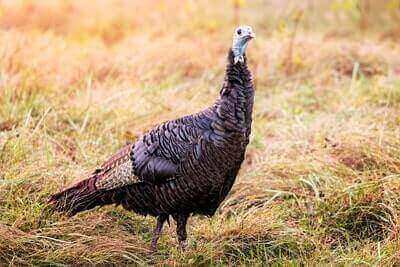
11. Camouflage
When learning how to scout turkeys, using camouflage clothing is essential for blending into the natural surroundings and minimizing the chances of being detected by wary birds. Turkeys have keen eyesight and can easily spot movement or unusual colors against the backdrop of the forest.
Therefore, wearing camouflage clothing that matches the terrain and vegetation helps hunters remain undetected while observing turkey behavior. Camouflage patterns that mimic the colors and textures of the hunting environment, such as woodland or leafy patterns, are particularly effective for blending into the surroundings.
Additionally, choosing lightweight and breathable camouflage attire ensures comfort during long hours of scouting in various weather conditions. By wearing camouflage clothing, hunters can increase their stealthiness and improve their chances of getting close to turkeys without alarming them, facilitating more successful scouting experiences.
The Bottom Line
How to scout turkeys takes a little bit of time and effort but can pay dividends when the hunting season opens. There are a few things you can do to scout for turkeys that will give you the information you need. In this article, we discussed some of the ways you can scout for turkeys.
How to scout turkeys is a hunting skill that you can get good at once you commit to it and put in the work. To help you become more successful when hunting turkeys, we discussed the best turkey hunting tips in this article. You can also read how to scout the hunting ground, how to scout for deer, how to hunt snipe, and how to scout for ducks.
